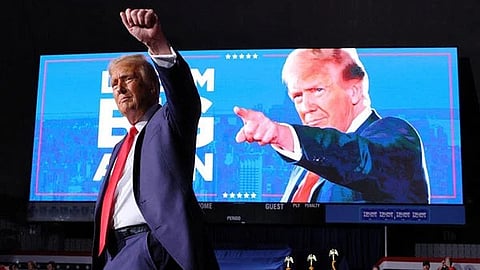

Amidst the fall admission cycle to American universities, uncertainty looms large for international students. With tighter visa scrutiny under President Donald Trump’s new regime, many Indian students fear their chances of approval are getting slimmer.
Let’s look at the data: About 6,000 international students in the USA had their visas revoked by the State Department in the last 9 months, while new visas issued to Indian students declined by 30 per cent.
Further, a report by the Institute of International Education found that 35 per cent of US colleges reported falling enrolments this year. Data from June 2025 also shows Indian arrivals down by 46 per cent.
These concerns deepened when the USA halted visa interviews in June to resume them with enhanced social media scrutiny. With everything going on, now seems like a difficult time to be an international student in the USA.
The mood, as per experts, is grim. “Students are reconsidering going to the USA for higher education,” says Anusha Bheri, Managing Partner at Bheri Overseas.
She explains that students already in the US are warning their relatives against applying.
“Due to the new salary criteria for H-1B visas and the lack of clarity on OPT, students are finding it difficult to sustain themselves,” she recounts.
This begs the question: Is the American Dream now distant for Indian students?
Fear & misinformation rife
Several experts point to widespread misconceptions about the new visa regime, fueled by panic and ignorance. The most prevalent myth is that the Trump administration has banned Indian students.
“Bad news travels faster. Moreover, a lot of people get their news from social media and sensationalised news coverage, which is often not factual and lacks nuance. There is no ban on Indian students, just more scrutiny — on all international students,” clarifies Anusha.
Many experts point out that the USA cannot afford to impose such a ban.
“US universities depend heavily on international talent — not only for tuition revenue but also for research and innovation. Nearly 54 per cent of US STEM graduate students are international,” Vibha Kagzi, Founder & CEO of ReachIvy, points out.
This also stems from recent legal battles between the Trump administration and several American universities, where the issue of international students became a flashpoint.
That universities are accepting international students, while the administration isn’t, is also false, says Manisha Zaveri, Joint MD, Career Mosaic. She adds, “Several students are not only receiving their visas but are already in the USA.”
Law & order, not racism
While Trump’s detractors call these changes racist and xenophobic, supporters see this as “putting America first.”
Experts suggest a middle ground: that the new rules are aimed at ensuring international students comply with US laws.
“If I invite someone to my place, I would like them to behave themselves. The same is the case with the USA’s new rules,” says Saurabh Arora, Founder & CEO of University Living.
He adds that the new visa regime addresses several issues, such as improper documentation, overstaying, flouting traffic rules, and displaying “anti-American sentiments”.
Echoing this, Manisha says, “The USA is expecting international students to be more accountable for their behaviour, and adhere to US laws. They face the same scrutiny as all other immigrants.”
Further, Vibha adds that Indian students have little to fear, as such “disruptive behaviour” has not been observed among Indian students. “They often have a very hectic academic life,” she points out. She adds that now, visa rejections are due to weak applications and interviews, not discrimination.
More options for students
While one might speculate endlessly on the intent of these rules and their fallout, students are already looking beyond the USA.
Experts say that the UK, Ireland, Australia, New Zealand and Germany remain reliable alternatives, while the UAE, China, Singapore, Japan and South Korea are emerging contenders.
“These countries offer diverse, more affordable programmes, post-study work opportunities, and even citizenship pathways,” Anusha says.
Through this approach, they would also mitigate the risk of rejection. Saurabh says, “Students prefer safer alternatives if rejection rates or waiting periods rise.”
Manisha observes that applicants are now more deliberate. “If they want academic rigour, they choose American universities. If they want settlement pathways, they choose countries that provide them,” she explains.
Students may also turn to transnational education, studying at US universities’ offshore campuses to reduce immigration risks while retaining academic quality. “They could split their education between the US and other partner countries,” Vibha suggests.
Better safe — and law-abiding — than sorry
For students who want to stick to their US plans, the advice is simple: Do not break the law. Students must maintain a full course load, avoid unauthorised work, and report any address changes. They should also be mindful of their social media presence.
“It’s not about restrictions, but safety,” Vibha says.
Students should also maximise their time in the US. “Strengthen your profile, upskill to match market demands, and explore jobs or higher studies,” advises Anusha.
Networking and contributing locally also matter. “Create value for your university, community and employers,” says Saurabh. He adds, “If you want to stay beyond education, provide a compelling reason.”
Finally, students must not lose sight of the larger picture. “You know that you aren’t there to break any rules or dupe the system. If your intentions are proper, there’s no need to be afraid,” Manisha says.
